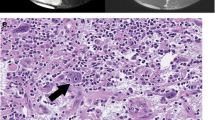Abstract
Definition: Sarcoma with melanocytic differentiation of tendons and aponeuroses.
Access provided by Autonomous University of Puebla. Download chapter PDF
Similar content being viewed by others
Keywords
These keywords were added by machine and not by the authors. This process is experimental and the keywords may be updated as the learning algorithm improves.
Definition: Sarcoma with melanocytic differentiation of tendons and aponeuroses.
Epidemiology: Very rare, females, average age of 25 years.

Location: Foot, ankle, knee, and upper limb.
Clinical: Slowly growing, moderate size, painless, globose mass.
Diagnosis: On MRI, elliptical, smoothly outlined mass, slightly or markedly hyperintense on T1, white lesion with multiple low-intensity septations on T2, homogeneous enhancement after gadolinium.
Histopathology: Adherent to a tendon or to an aponeurosis, but not to the subcutaneous or to the skin. Firm, globose, well-defined boundaries, capsulated appearance. Round, oval, spindle cells with clear cytoplasm. Nuclei are round, ovoid or elongated, vesicular, with a large nucleolus. Mitotic figures are rare. Cells are arranged in nests surrounded by a fine reticular stroma or rough collagen bands that may give an almost acinar or glandular impression at first glance. Immunohistochemistry shows consistent positivity for S-100, HMB45, MART-1, and MiTF. Molecular findings are characterized by a specific translocation: t(12;22)(q13;q12), with an EWS-ATF1 fusion transcript.
Course and Staging: Local recurrences are frequent when treatment is inadequate due to the not very aggressive clinical presentation. Metastases are late (>6 years) but very frequent in lymph nodes and lungs. Usually, stage II B.
Treatment: Very wide or radical excision with regional lymph nodes.
FormalPara Immunohistochemical PanelS100 | + |
HMB45 | + |
MART-1 | + |
Mitf | + |
t(12;22) (q13;q12) | EWSR1-ATF1 (type 1, type2) | >90 % |

Spindle cell neoplasm with optically clear cytoplasms
Selected Bibliography
Dim DC, Cooley LD, Miranda RN (2007) Clear cell sarcoma of tendons and aponeuroses: a review. Arch Pathol Lab Med 131(1):152–156. Review
Kosemehmetoglu K, Folpe AL (2010) Clear cell sarcoma of tendons and aponeuroses, and osteoclast-rich tumour of the gastrointestinal tract with features resembling clear cell sarcoma of soft parts: a review and update. J Clin Pathol 63(5):416–423. Review
Malchau SS, Hayden J, Hornicek F, Mankin HJ (2007) Clear cell sarcoma of soft tissues. J Surg Oncol 95(6):519–522. Review
Meis-Kindblom JM (2006) Clear cell sarcoma of tendons and aponeuroses: a historical perspective and tribute to the man behind the entity. Adv Anat Pathol 13(6):286–292. Review
Sandberg AA, Bridge JA (2001) Updates on the cytogenetics and molecular genetics of bone and soft tissue tumors: clear cell sarcoma (malignant melanoma of soft parts). Cancer Genet Cytogenet 130(1):1–7. Review
Author information
Authors and Affiliations
Corresponding author
Editor information
Editors and Affiliations
Rights and permissions
Copyright information
© 2014 Springer International Publishing Switzerland
About this chapter
Cite this chapter
Gambarotti, M. (2014). Clear Cell Sarcoma. In: Picci, P., Manfrini, M., Fabbri, N., Gambarotti, M., Vanel, D. (eds) Atlas of Musculoskeletal Tumors and Tumorlike Lesions. Springer, Cham. https://doi.org/10.1007/978-3-319-01748-8_79
Download citation
DOI: https://doi.org/10.1007/978-3-319-01748-8_79
Published:
Publisher Name: Springer, Cham
Print ISBN: 978-3-319-01747-1
Online ISBN: 978-3-319-01748-8
eBook Packages: MedicineMedicine (R0)




